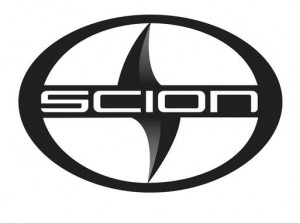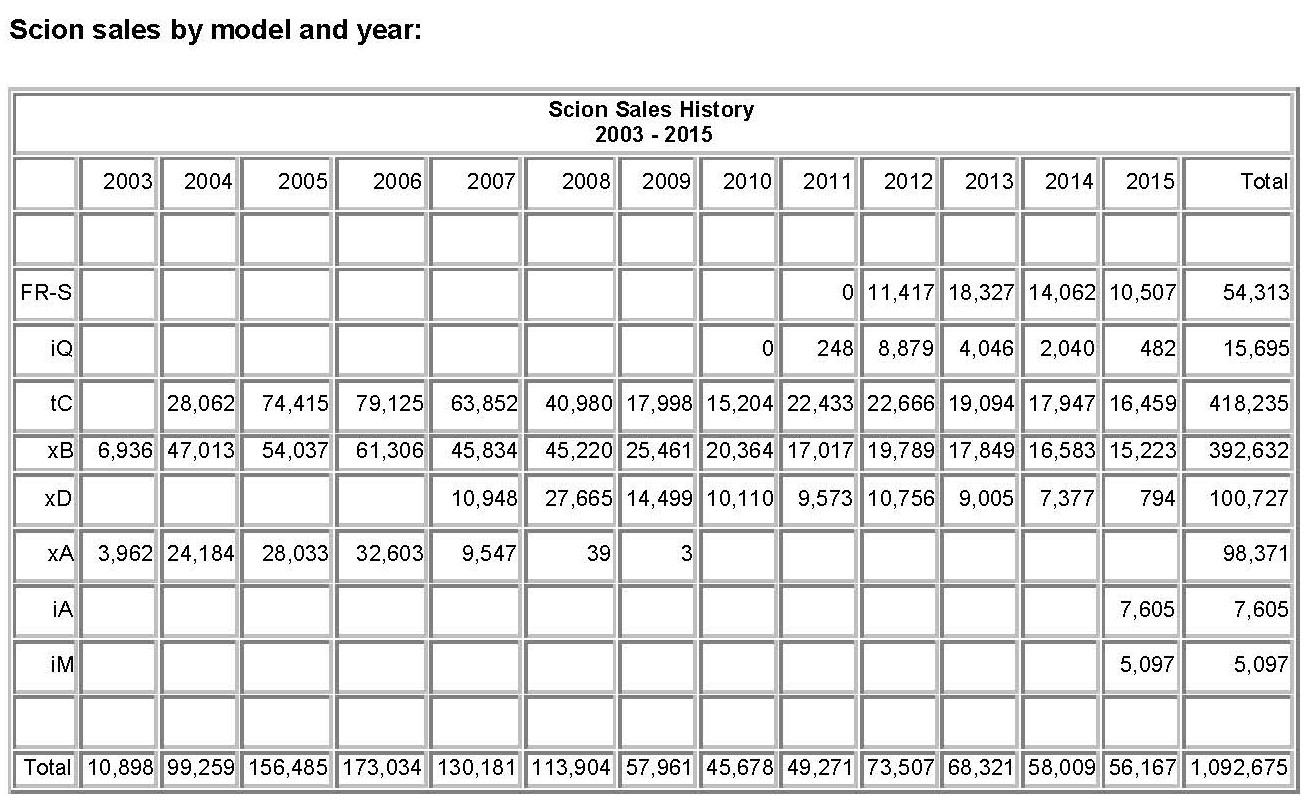Valuable Insights Will Aid Toyota in Attracting New, Young Customers
 TORRANCE, Calif., Feb. 3, 2016 – Scion, established as a separate brand in 2003 as a laboratory to explore new products and processes to attract youth customers, is now transitioning back to the Toyota brand. Scion achieved its goals of developing unique products and processes, and bringing in new, younger customers to Toyota. With more than a million cars sold, 70 percent of Scions were purchased by customers new to Toyota and 50 percent were under 35 years old.
TORRANCE, Calif., Feb. 3, 2016 – Scion, established as a separate brand in 2003 as a laboratory to explore new products and processes to attract youth customers, is now transitioning back to the Toyota brand. Scion achieved its goals of developing unique products and processes, and bringing in new, younger customers to Toyota. With more than a million cars sold, 70 percent of Scions were purchased by customers new to Toyota and 50 percent were under 35 years old.
“This isn’t a step backward for Scion; it’s a leap forward for Toyota. Scion has allowed us to fast track ideas that would have been challenging to test through the Toyota network,” said Jim Lentz, founding vice president of Scion and now CEO, Toyota Motor North America. “I was there when we established Scion and our goal was to make Toyota and our dealers stronger by learning how to better attract and engage young customers. I’m very proud because that’s exactly what we have accomplished.
“We could not have achieved the success we have had without the incredible support of Scion’s customers, dealers and team members, so supporting them throughout this transition process will be one of our top priorities,” said Lentz.
Toyota’s decision was made in response to customers’ needs. Today’s younger buyers still want fun-to-drive vehicles that look good, but they are also more practical. They, like their parents, have come to appreciate the Toyota brand and its traditional attributes of quality, dependability and reliability. At the same time, new Toyota vehicles have evolved to feature the dynamic styling and handling young people desire.
Scion has consistently been the youngest brand in the auto industry with an average age of 36 years old. At 29, the tC sports coupe has the lowest-average age buyer in the industry. The most recent additions to the line-up, the iA sedan and iM 5-door hatchback, are bringing in new buyers with 70 percent being first-time new car purchasers. Additionally, more than 50 percent of iM and iA buyers are under 35 years old.
As part of the brand transition, beginning in August 2016, MY17 Scion vehicles will be rebadged as Toyotas. The FR-S sports car, iA sedan and iM 5-door hatchback will become part of the Toyota family. The tC sports coupe will have a final release series edition and end production in August 2016. The C-HR, which recently debuted at the L.A. Auto Show, will be a part of the Toyota line-up.
The service and repair process for Scion customers will be unaffected by this change as customers will continue to visit Toyota dealerships’ service departments.
“We appreciate our 1,004 Scion dealers and the support they’ve given the brand,” said Bob Carter, Toyota senior vice president of automotive operations. “We believe our dealers have gained valuable insights and have received a strong return on their investment. During this time of transition, we will work closely with them to support this process and help communicate this change to customers.”
Scion’s 22 dedicated team members, who represent sales, marketing, distribution, strategy, and product and accessories planning, will have the opportunity to take on new jobs at Toyota Motor Sales, U.S.A., Inc. in Torrance. Scion regional representatives will assume different responsibilities in their respective Toyota sales offices.
“Scion has had some amazing products over the years and our current vehicles are packed with premium features at value prices,” said Andrew Gilleland, Scion vice president. “It’s been a great run and I’m proud that the spirit of Scion will live on through the knowledge and products soon to be available through the Toyota network.”
Scion Accomplishments:
Scion Processes – Scion served as a laboratory for products and key sales and marketing processes that have provided valuable lessons for other Toyota brands:
- Pure Pricing – dealers set a price for a car and customers did not need to negotiate
- Mono-Spec cars – providing cars with only two options: transmission and color
- Personalization – offering a large array of accessories to help customers customize their vehicles
- Pure Process – transparent financing process
- Pure Process Plus – an online system so much of the car-purchase process could be completed online
- Scion Service Boost – pre-paid maintenance plan
- Release Series – dynamic life cycle management through special features and options
- Grassroots marketing – initial Scion brand was “discovered” by customers through unique events
Scion Products — Scion has had some outstanding products that have made an impact in the industry including the original “box,” the xB and the FR-S affordable sports car. The tC sports coupe has consistently attracted the youngest buyer in the industry.
Scion Executives — Scion served as an important training ground for Toyota vice presidents, many of whom have been promoted to other roles:
- Jim Lentz — Chief Executive Officer, Toyota Motor North America
- Mark Templin – Managing Officer, Toyota Motor Corporation, Executive Vice President, Lexus International
- Jack Hollis – Group Vice President, Toyota Marketing
- Doug Murtha – Group Vice President, Corporate Strategy and Planning, Toyota Motor North America
- Andrew Gilleland – current Vice President, Scion
Scion Fact Sheet
Scion was established in 2003 as a test laboratory division for Toyota Motor Sales (TMS), U.S.A., Inc. It was designed to offer products and processes that stood apart from the crowd. Scion offered distinctive vehicles that reflected owners’ passions. Scion also appealed to a younger audience by offering a simple, no-haggle buying experience and by engaging with potential customers in meaningful and creative ways.
Model Line-Up: From the start, Scion sought to develop stylish and youthful vehicles that didn’t sacrifice on fun or safety. With an unparalleled combination of low pricing and driving dynamics, these models capture the “spirit of Scion.”
- iM* five-door hatchback: Launched in September 2015, the all-new iM incorporates form and function in a
compact hatchback. - iA* sports sedan: Introduced in 2015, the all-new iA is Scion’s first sedan and combines sporty handling with fourdoors, a trunk and an affordable price tag.
- FR-S* rear-wheel drive sports car: The FR-S stole the show when it was launched in 2013 and continues to be apopular choice for a true sports car at a competitive price.
- tC sports coupe: Since its debut in 2004, the tC has become Scion’s biggest seller to young customers.
- The tC sports coupe will have a final release series edition and end production in August 2016
- C-HR Concept: Debuted at the L.A. Auto Show in November 2015. When the production model arrives, it will be part of the Toyota line-up.
- xA subcompact: The first of Scion’s entries into the small-car market was available from 2003 – 2008.
- xB: The iconic “box” put Scion on the map in 2003. A second-generation xB was introduced in 2008. The xB ended production in December 2015.
- xD urban subcompact hatch: Replaced the xA in August 2008 and was discontinued in 2014.
- iQ premium micro-subcompact: Scion’s smallest car came to market in October 2011 and exited the line up in 2015.*Beginning in August 2016, MY 2017 vehicles will be badged as Toyotas
Scion Dealers: 1004
Scion Team Members: 22
Total Scion Vehicles Sold: More than 1 million units from 2003-2015
History
2003 – Sales: 10,898
- June — Scion starts selling 2003 xA and xB in California.
- Introduces mono-spec vehicles with extensive customization. Pure price means dealers advertise one
price and there’s no haggle and no hassle. - September – Scion expands to East Coast and subsequently rolls out throughout the nation.
2004 – Sales: 99,259
- March – the first of Scion’s extensive Release Series models, the xB RS 1.0, is revealed. Scion
uses Release Series as a unique lifestyle refresh tool throughout its history - July – Scion introduces 2005 tC which has the look of a sport coupe with the functionality of a
hatchback.
2005 – Sales: 156,485
2006 – Sales: 173,034
2007 – Sales: 130,181
- April — Second-generation 2008 xB goes on sale August –2008 xD urban five-door subcompact replaces xA.
2008 – Sales: 113,904
2009 – Sales: 57,961
2010 – Sales: 45,678
- August – Second-generation 2011 tC introduced
2011 – Sales: 49,271
- April — FR-S concept shown at New York International Auto Show
- October – 2012 Scion iQ premium micro sub-compact car goes on sale
2012 – Sales: 73,507
- April – 2013 FR-S sports car speeds into the Scion line-up
- September — Scion launches “What Moves You” ad campaign
2013 – Sales: 68,321
2014 – Sales: 58,009
- November – iM Concept car debuts at L.A. Auto Show
2015 – Sales: 56,167
- September – Scion iM 5-door hatchback and iA subcompact sedan added to line-up
- October – Scion introduces new “Weird, Right?” ad campaign for iM and iA,
- November – C-HR Concept, the compact high-ride with distinctive styling, was introduced at the L.A.
Auto Show

